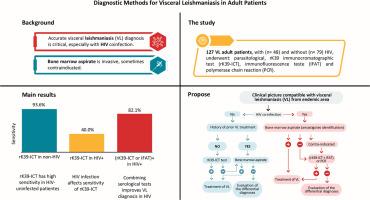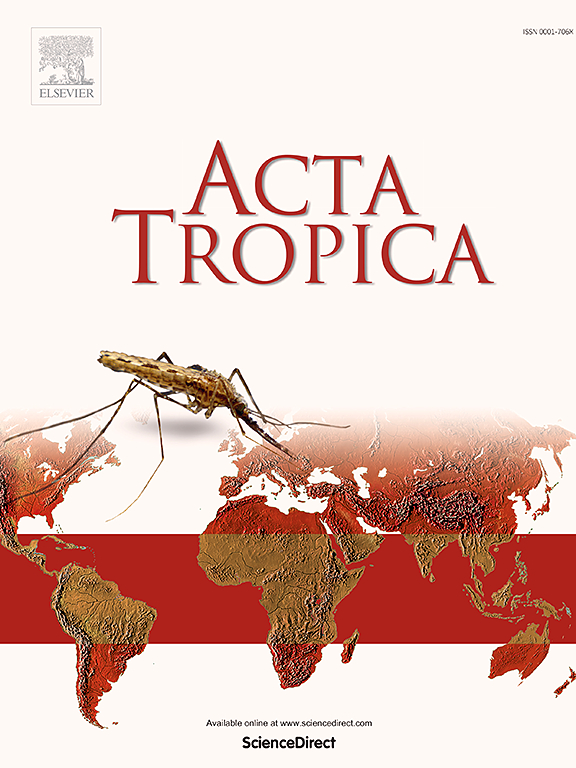Accuracy evaluation of diagnostic methods for visceral leishmaniasis in adult patients with and without HIV infection: Clinical management implications
IF 2.1
3区 医学
Q2 PARASITOLOGY
引用次数: 0
Abstract
Visceral leishmaniasis (VL) poses a serious health threat, particularly when untreated, necessitating accurate diagnosis. While the gold-standard method involves identifying amastigotes in bone marrow aspirate (BMA), this procedure is invasive and occasionally contraindicated. Additionally, when VL is associated with HIV infection the serologies accuracies could be affected. This study aims to evaluate and compare diagnostic methods for VL in patients with and without HIV coinfection. We enrolled prospectively 127 consecutive adult VL patients, 48 (37.8%) of whom had HIV coinfection, in Brazil's Midwestern region, where VL is endemic. Parasitological examination served as the reference standard for accuracy analysis, with index tests including immunofluorescent antibody test (IFAT), immunochromatographic test with rK39 protein (rK39-ICT), and blood polymerase chain reaction (PCR). Specificity assessment involved 430 healthy blood donors from the same endemic area. Ninety-two patients had parasitologically confirmed VL. Among HIV-uninfected patients, rK39-ICT exhibited sensitivity comparable to PCR (93.6%; 95% CI: 83.6–100 vs. 97.8%; 95% CI: 93.6–99.2, respectively) and superior to IFAT (71.1%; 95% CI: 57.9–84.3). However, in HIV-infected patients, rK39-ICT sensitivity was notably lower than PCR (40.0%; 95% CI: 22.5–57.5 vs. 97.4%; 95% CI: 92.5–98.9) and similar to IFAT (67.5%; 95% CI: 52.9–82.0). Combining two serological tests in parallel identified 82.1% of parasitologically confirmed VL cases, with a negative likelihood ratio significantly lower than either test alone. No test achieved a specificity of 90%, and there were no significant differences in specificity observed among the index tests. The positivity rate of parasitological examination in the 127 VL patients was higher in HIV-infected compared to HIV-uninfected patients, 91.3% (95% CI: 83.2–99.4) versus 67.6% (95% CI: 56.9–78.3), respectively. These findings underscore the necessity of accounting for HIV infection when choosing VL diagnostic methods. Although rK39-ICT provides reliable results in HIV-uninfected patients, BMA examination remains crucial for accurate diagnosis in individuals with HIV/AIDS. In cases where bone marrow aspiration is contraindicated, employing IFAT and rK39-ICT in parallel could be considered, as the occurrence of both positive results is uncommon in healthy individuals from endemic areas.

对感染和未感染 HIV 的成年患者内脏利什曼病诊断方法的准确性评估:对临床管理的影响。
内脏利什曼病(VL)对健康构成严重威胁,尤其是在未经治疗的情况下,因此必须进行准确诊断。虽然黄金标准方法是在骨髓抽吸物(BMA)中识别非主凝集体,但这一过程具有侵入性,有时会有禁忌。此外,当 VL 伴有 HIV 感染时,血清学的准确性也会受到影响。本研究旨在评估和比较合并和未合并 HIV 感染患者的 VL 诊断方法。我们在 VL 流行的巴西中西部地区连续招募了 127 名成年 VL 患者,其中 48 人(37.8%)合并有 HIV 感染。寄生虫学检查是准确性分析的参考标准,指标检测包括免疫荧光抗体检测(IFAT)、rK39 蛋白免疫层析检测(rK39-ICT)和血液聚合酶链反应(PCR)。特异性评估涉及来自同一流行地区的 430 名健康献血者。92 名患者经寄生虫学证实患有 VL。在未感染 HIV 的患者中,rK39-ICT 的灵敏度与 PCR 相当(分别为 93.6%;95% CI:83.6-100 与 97.8%;95% CI:93.6-99.2),优于 IFAT(71.1%;95% CI:57.9-84.3)。然而,在 HIV 感染者中,rK39-ICT 的灵敏度明显低于 PCR(40.0%;95% CI:22.5-57.5 vs. 97.4%;95% CI:92.5-98.9),与 IFAT 相似(67.5%;95% CI:52.9-82.0)。同时使用两种血清学检测方法可鉴定出 82.1% 的寄生虫学确诊 VL 病例,其阴性似然比明显低于单独使用任何一种检测方法。没有一种检测的特异性达到 90%,而且各指标检测的特异性没有明显差异。在 127 例 VL 患者中,HIV 感染者的寄生虫学检查阳性率高于 HIV 未感染者,分别为 91.3%(95% CI:83.2-99.4)和 67.6%(95% CI:56.9-78.3)。这些发现强调了在选择 VL 诊断方法时考虑 HIV 感染的必要性。尽管 rK39-ICT 可为未感染 HIV 的患者提供可靠的结果,但骨髓穿刺检查对于准确诊断 HIV 感染者/艾滋病患者仍然至关重要。在骨髓穿刺有禁忌的情况下,可以考虑同时采用 IFAT 和 rK39-ICT 方法,因为在流行地区的健康人中,同时出现这两种阳性结果的情况并不常见。
本文章由计算机程序翻译,如有差异,请以英文原文为准。
求助全文
约1分钟内获得全文
求助全文
来源期刊

Acta tropica
医学-寄生虫学
CiteScore
5.40
自引率
11.10%
发文量
383
审稿时长
37 days
期刊介绍:
Acta Tropica, is an international journal on infectious diseases that covers public health sciences and biomedical research with particular emphasis on topics relevant to human and animal health in the tropics and the subtropics.
 求助内容:
求助内容: 应助结果提醒方式:
应助结果提醒方式:


